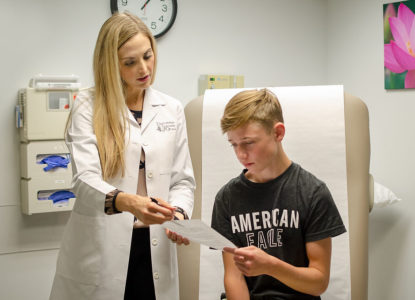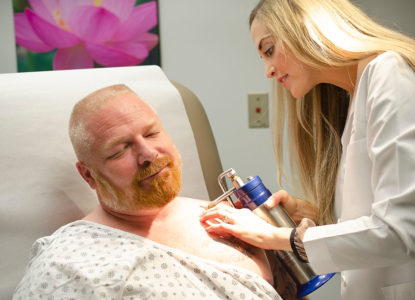At Dermatology Specialists of Omaha, our board-certified dermatologists are experts in treating diseases affecting the skin, hair and nails. We also utilize well-trained Physician Assistants in our team-based approach to treating skin disease. Some common conditions that our providers treat include:


Psoriasis
Psoriasis is a relatively common skin condition that affects 2-3% of the population. Psoriasis is caused by an overactive immune system and commonly presents as pink, thick plaques of skin on the elbows, knees, or scalp. The condition can worsen with stress or infections and often improves with sun exposure. Initial treatment often involves topical steroids but in more severe cases, oral or injectable medications may be necessary. For more information, visit the National Psoriasis Foundation at www.psoriasis.org
Atopic Dermatitis (eczema)
Atopic Dermatitis (eczema) is an immune-mediated condition that involves skin barrier dysfunction. The condition often affects young children and improves with age. Developing a skin care regimen is key to managing this chronic condition. Prescription medication is often utilized for flare-ups, and can help reduce itching and rash.
Dyshidrotic Eczema
Dyshidrotic Eczema is form of eczema that features itchy blisters on the hands and/or feet. This can be exacerbated by heat, sweat or exposure to allergens.
Nummular Eczema
Nummular Eczema commonly occurs on the upper or lower extremities and appears as red, coin-shaped patches of itchy skins. This form of eczema often develops in adulthood or in the elderly population.
Stasis Dermatitis
Stasis Dermatitis occurs on the lower legs and is often seen in conjunction with leg swelling and tired veins that have difficulty pumping blood back to the heart. Itchy red rashes can occur in this setting and may be mistaken for cellulitis.
Seborrheic Dermatitis
Seborrheic Dermatitis is a condition that affects oily areas of the body such as the scalp, ears, eyebrows and chest. It appears as pink, greasy patches of skin and is a reaction to naturally occurring yeast that lives on the skin.
Contact Dermatitis
Contact Dermatitis is a form of eczema that occurs when a substance comes into contact with the skin. Two forms exist, irritant contact dermatitis and allergic contact dermatitis. Irritant contact dermatitis occurs when chemicals or physical agents damage the skin due to repeated exposure. The most common irritants are soap and water, solvents, acids, alkalis and friction. Allergic contact dermatitis is immune-mediated, occurring after repeated exposure to a substance. Common substances to cause allergic contact dermatitis include metals, preservatives and fragrances. Contact dermatitis is often symmetric and often affects the face, eyelids and/or the hands. If you are diagnosed with allergic contact dermatitis, your dermatologist may recommend patch testing. Patch testing is a procedure used to determine what specific allergen(s) is causing the rash. This can be extremely helpful in eliminating exposures and clearing the dermatitis.
Acne
Nearly everyone suffers from acne at some stage in life. Whether you are a teenager, a new mom or even menopausal, the providers at DSO can customize a treatment plan to treat your type of acne.
Rosacea
Rosacea is similar to acne in appearance but features prominent redness and easy flushing. Dietary factors can influence rosacea. For example, spicy foods and alcohol will worsen redness and flushing due to their ability to dilate the blood vessels in the skin. Differentiating between acne and rosacea is important when formulating a treatment plan. Our providers at DSO can customize a treatment plan best fit for you.
Lichen Planus
Lichen Planus is an itchy skin rash that features purplish scaly bumps. While the rash can occur anywhere, it favors the lower legs, ankles and wrists. Rarely, mucosal surfaces such as the mouth or genitals can be affected with open sores. The immune system plays a role in this skin condition, although the exact cause is not known.
Cutaneous Lupus
Lupus is an autoimmune condition that can affect organ systems as well as the skin. In some cases, only the skin is involved. Hallmark symptoms include rash in sun-exposed areas including the face, neck and chest. Patients often experience skin breakouts when exposed to the sun. The rash is often red, scaly and can be crusted or even form blisters. Other signs/symptoms that may indicate systemic disease include joint pain or stiffness, fatigue, mouth sores and lab abnormalities.
Hidradenitis Suppurativa
Hidradenitis Suppurativa (HS) is due to inflammation and blockage of hair follicles. This causes painful bumps in skin fold areas. Lesions can drain and even rupture. The condition is associated with weight gain as well as tobacco use and usually develops after puberty. If you are suffering from this condition, our Board-Certified Dermatologists and Physician Assistants can formulate a treatment plan for you.
Hyperhidrosis
Hyperhidrosis, or excess sweating, can be a life-altering condition. Excess sweating affects nearly 5% of the population and can cause embarrassment and inhibit certain activities. Hyperhidrosis can affect numerous areas of the body including the underarms, hands, feet, and can even be generalized. Fortunately, there are effective treatments for this condition. If you suffer from hyperhidrosis, contact DSO today for evaluation and treatment.
Hair Loss
Androgenic Alopecia (male and female pattern hair loss)
This type of hair loss often runs in families and is influenced by hair follicle sensitivity to hormones. Typical distribution includes the temples and top of head in men and the crown of scalp in women.
Telogen Effluvium
Telogen Effluvium is hair loss that can be best described as “diffuse shedding”. Factors such as stress, recent illness or surgeries, giving birth, and certain hormone or vitamin imbalances can stimulate this type of hair loss.
Alopecia Areata
Scattered, coin-shaped areas of hair loss characterize Alopecia Areata. This condition is due to the immune system attacking the hair follicle. Other areas of the body can be involved including the eyebrows, eyelashes and beard. Alopecia Areata can progress to Alopecia Totalis (complete loss of hair on the head) and Alopecia Universalis (loss of all body hair). The National Alopecia Areata Foundation can be a helpful resource for patients.
Traction Alopecia
Traction alopecia is due to hair breakage near the temples and front of the scalp. Certain hairstyles such as tight braids, twists and tight ponytails can cause traction alopecia due to the stress put on the hair shaft.
Scarring Alopecia
There are several types of scarring alopecia, which can sometimes be differentiated by scalp biopsy. Once the underlying cause of the scarring hair loss is identified, our providers can formulate a treatment plan to prevent further hair loss. Once scarring occurs, the hair that has been lost cannot be regrown.
Itchy Skin
Itching without a rash can have numerous potential causes. Possible etiologies include medications, internal disease processes, neuropathy, autoimmune skin diseases and contact allergies to name a few. If you are suffering from itchy skin, contact our clinic for an evaluation.
Rashes
Common causes of full body rashes include an allergic reaction to a medication, contact dermatitis (allergy to something touching the skin), and autoimmune conditions. Some more serious rashes will cause blisters to form on the skin. If you develop a full body rash, you should contact DSO for swift evaluation and treatment.
Lumps/Bumps
New skin growths are a common reason for an appointment at DSO. If you detect a new growth on the skin that appears different than other spots on your skin, it is best to have it evaluated. Common non-harmful skin growths are described below.
Seborrheic Keratosis
Seborrheic Keratosis is a skin lesion that most commonly develops after age thirty. We accumulate more of these growths with birthdays. They are often brown in color, can be waxy or scaly, and may appear “stuck-on” the skin.
Dermatofibroma
Dermatofibroma is a somewhat firm bump that often occurs on the extremities and is due to mild trauma. It can be tan, brown or pink in color.
Epidermal Inclusion Cyst
Epidermal Inclusion Cyst is a common bump that occurs under the top layers of skin and may have a pore overlying it. These growths accumulate dead skin cells and material can be expressed with squeezing (we don’t recommend picking or draining yourself).
Pilar Cyst
Pilar Cyst is a smooth bump that occurs on the scalp. They are often multiple and can run in families. If lesions become very large, hair loss can occur over the bump.
Lipoma
Lipoma is a fatty tissue growth that occurs under the skin and often feels somewhat rubbery and easily moveable. Lipomas are commonly on the arms and legs, and some genetically prone individuals will develop numerous lesions.
Angioma
Angioma is a very common growth that appears like a “cherry red” spot on the skin. They can occur anywhere but are very common on the trunk.
Pyogenic Granuloma
Pyogenic Granuloma is a larger “cherry red” growth made of blood vessels that often protrudes from the skin and may bleed easily.
Warts
Warts are growths that are caused by the Human Papilloma Virus (HPV). Warts develop by direct contact with viral particles, often by contact with another person that has a wart. Different strains of the virus cause different types of warts including plantar warts, common warts, flat warts and genital warts. Our Board Certified Dermatologists and Physician Assistants utilize several in-office and home modalities to treat warts including destructive methods and immune modulating therapy.
Fungal Infections
Fungal infections are relatively common and can occur due to contact with another infected person, animal, or even from dirt and soil. Fungal infections can occur anywhere on the body including the scalp, genital area, hands, feet and nails. The rash is often pink and scaly with a well-demarcated border. When on the scalp, hair loss can occur. Treatment is often with topical and/or oral anti-fungal medications.
Skin Cancer
Skin cancer is the uncontrolled growth of malignant skin cells. This process starts with mutations in the skin cells, most commonly due to ultraviolet exposure from outdoor sun or tanning beds. Rapid growth of skin cells ensues, leading to a tumor. The most common skin cancers are basal cell carcinoma, squamous cell carcinoma and melanoma. Our providers at DSO are skilled at detecting skin cancer as well as removing all types of skin cancer. This can be done in a variety of ways depending on the type and location of the skin cancer. Mohs surgery is utilized when removing skin cancers in areas where there is minimal skin to work with, such as the face, ears, scalp, neck and lower legs. For more in-depth information on the specific types of skin cancer, see the following link: https://www.skincancer.org/skin-cancer-information
Bacterial Infections
Bacterial infections that affect the skin are most commonly due to the germ called Staphylococcus aureus. Most staph infections affecting the skin are mild and present as a large pimple or boil. Impetigo is a form of staph infection that can appear as honey-colored crusting on the face, more commonly in children. Staph infections can also present as a red, hot and swollen area on the skin called cellulitis. Factors that make infection more common include close contact with infected persons, heat, sweat and a compromised immune system.
